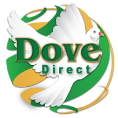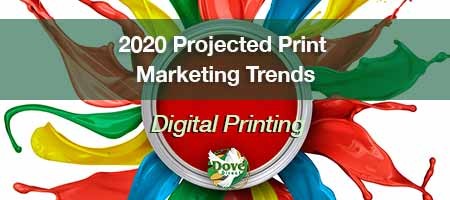Dove Direct Print and Marketing Blog, “Does Your Brand Recall Exceed 1%?”
Welcome to the Dove Direct Print and Marketing Blog. Today's post, "Does Your Brand Recall Exceed 1%?" examines how brand recall can affect your business presentations, marketing initiatives, and advertising strategies. The business dictionary defines brand recall as, "A qualitative measure of how well a brand name is connected with a product type or class of products by consumers. Often tested through surveys or interviews, brand recall is measured by asking participants questions such as "name as many car models as possible" or "can you explain what a Kleenex is?" We contend that the business dictionary's definition of brand recall is a general overview. This view differs somewhat from a brand manager viewpoint.
Brand managers typically define brand recall as playing a critical role in persuading customers to remain loyal with your brand, including purchasing your brand on a regal basis. Some brand managers also suggest that brand recall occurs when consumers buy a particular product or service, consume it, continue to hold the brand in high value, and would purchase again from that same brand; thus translating that a positive brand experience tends to spark repeat consumer purchases.
Unaided versus Aided Brand Recall
Media and brand experts will state that there are two types of brand recall categories, aided recall, and unaided recall. Aided recall typically occurs when a question includes the brand name, either as part of a question or during the discussion. For example, aided brand recall happens when a consumer encounters a question, such as, "Do you remember the Acura Brand?" As one can see, asking about a brand by name aids the memory of the consumer.
By comparison, unaided brand recall stipulates that the consumer can remember a brand absent of brand name memory stimulation. When an unaided brand recall occurs, the brand is said to have achieved notable significance with consumers being able to recall the brand void of outside stimulus.
Brand Recall and Brand Recognition
Many brand managers are of the mind that there are two methods for analyzing brand recall. The examples mentioned above of aided versus unaided brand recall represent one way to survey brand recall.
Brand recognition, on the other hand, refers to consumers seeing a brand, for example, in a movie where the brand is placed in a scene, such as a Pepsi bottle or can, or an action sequence, that features an Audi. Thereafter, when a consumer visits a supermarket and strolls down the beverage aisle, the Pepsi brand will stand out among the other soda brands. This type of brand recognition also occurs when the consumer enters the buying cycle to purchase a new automobile, and they recall how cool the Audi looked on the big screen, thus prompting them to include an Audi dealership in their vehicle search.
Brand recall is a different beast when compared to brand recognition, as brand recall does not originate from external stimuli. There are those that would argue that brand recall cannot exist without brand recognition. As far as consideration of iconic brands, that statement could hold, particularly when measured against sales and marketshare. However, mid-size and enterprise-sized brands, while not considered iconic, can exhibit high brand recall for their market niche.
How about that favorite pet groomer that can retain and grow simply from folks who have experience with the brand? What about online businesses that offer top notch customer services and continue to expand their customer base? We contend that the brand experience plays a significant role in elevating brand recall. In short, those examples represent both brand recognition and brand recall based on customer experiences.
Unaided Brand Recall Depends On Memory
Marketshare, brand equity, and competitive awareness all rely on what consumers can remember about a brand. The ability for brands to command memorable experiences is critical for business and sales objectives. Why? Customers arrive at positive brand decisions based on what they can recall, versus what they have forgotten. Would you be surprised to learn that in business contexts, folks tend to be more forgettable than they are memorable?
Carmen Simon is the author and founder of Memzy, a company that uses brain science to help corporations create memorable messages. Simon's most recent book, "Impossible to Ignore: Create Memorable Content to Influence Decisions," has won the acclaim of publications such as Inc.com, Forbes and Fast Company, and has been selected as one of the top international books on persuasion.
Simon states, "Using EEG (electroencephalogram) technology, we can detect what happens in the brain when exposed to a business presentation, and during studies we conduct monthly with corporate teams, we observe that people retain less than 1% of business content after 48 hours."
1% and 1%
In previous posts, we expounded on the 1% Thin Theory which stipulates that within any group of marketed targets, only 1% of those targeted are looking for the product or service at the moment they receive the advertising message. It's unclear whether that 1% is actually in need of the product, or if there is some effect as a result of brand recall, or brand recognition that also plays a role. Now consider Simon's postulate suggesting that people only retain 1% of business content 48 hours after exposure to that content.
Print Improves Brand Recall
Brands and marketers have to improve sales numbers and be able to implant brand recall as part of the overall objective within marketing strategies. With folks forgetting content at the rate of a 1% retention clip rate, it should come as no surprise that analyzing available marketing and advertising mediums for the best brand recall is of paramount concern.
In a digital is everything age, print rises to the top of memory retention and brand recall. Through print collateral, increased information is absorbed simply by reading printed documents; as readers tend to consume more as they are more deliberate, taking time to take in and understand the information. Conversely, when folks read via online destinations, they skim through the content and are often disrupted by incoming messages. As a result, they often miss valuable information and are willing to dismiss the message entirely before gaining insight into the message.
Memory retention represents a considerable drawback for brand recall. Print media provides a platform that enables readers to focus better, relax, and slow down. As a result, folks that are reading printed materials tend to achieve improved comprehension and memory retention over those who read the same material on a web site, social media, or email. The tactile experience of touching and manipulating pages makes connections between abstract concepts and the printed content. In short, print stimulates memory retention of consumed content.
The Net-Net
Marketers will continue to debate brand recall in the years to come, as digital and the IoT are pushing the content envelope. We contend that brands and marketing aspirants should be cognizant of attempting to raise the bar on memory retention, which in turn will elevate brand recall.
For now, print collateral does exceed that 1% retention rate, but the question remains, "How many brands understand that by adding print to the marketing mix they are already improving brand recall?" Thanks for reading, "Does Your Brand Recall Exceed 1%?"
Let's have a conversation about direct mail strategies, printing, print software, transactional documents, variable digital printing, brand equity and unified marketing collateral during our next Open House. We invite you to join us for an hour or two, June 27, from 10:30 am to 4:30 pm. Let us show you how to improve your document processes to optimize your workflow, reduce your costs, and maximize your organization's printing, letter shop and mailing capabilities. Dove Direct does have an official USPS certified bureau located within our offices that will save you time and money. And, if you bring us your files, we will create a demo file for you. For more information call Carla Eubanks at 404-629-0122 or email Carla at This email address is being protected from spambots. You need JavaScript enabled to view it..
Dove Direct, your Atlanta based print and mail solutions provider offers organizations end-to-end data, printing and mailing solutions: Data Management, Variable Digital Printing, LetterShop and Fulfillment, Fully Automated MLOCR Presort Bureau, Marketing and Production Management Support and Secure Data Life Cycle Management.
If you don't want to wait for the Open House, you can reach Dove Direct today by calling 404-629-0122 or use the contact form for Dove Direct.





